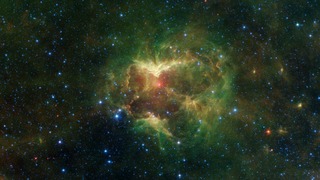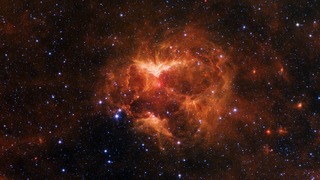
Credit: NASA/JPL-Caltech
Observation • October 30th, 2019 • ssc2019-17b
ssc2019-17b
This carved-out cloud of gas and dust has been nicknamed the "Jack-o'-lantern Nebula" because it looks like a cosmic hollowed-out pumpkin. Powerful outflows of radiation and particles from a massive star known as an O-type star and about 15 to 20 times heavier than the Sun has likely swept the surrounding dust and gas outward, creating deep gouges in the cloud. The image shows infrared light (which is invisible to the human eye) captured by NASA's Spitzer Space Telescope.
This image is a high-contrast version in which the red wavelength is more pronounced. Together, the red and green wavelengths create an orange hue. The picture highlights contours in the dust as well as the densest regions of the nebula, which appear brightest.
NASA's Jet Propulsion Laboratory, Pasadena, Calif., manages the Spitzer Space Telescope mission for NASA's Science Mission Directorate, Washington. Science operations are conducted at the Spitzer Science Center at the California Institute of Technology, also in Pasadena. Caltech manages JPL for NASA.
About the Object
- Name
- Jack-o'-lantern Nebula
- Type
- Nebula > Type > Star Formation
- Star > Spectral Type > O
Color Mapping
| Band | Wavelength | Telescope |
| Infrared | 3.6 µm | Spitzer IRAC |
| Infrared | 4.5 µm | Spitzer IRAC |
| Infrared | 8.0 µm | Spitzer IRAC |
| Infrared | 24.0 µm | Spitzer MIPS |
Astrometrics
- Position (J2000)
- RA =22h 22m 12.5s
- Dec = 58° 41' 5.1"
- Field of View
- 1.5 x 0.8 degrees
- Orientation
- North is 40.6° left of vertical







